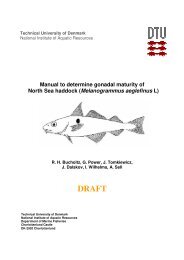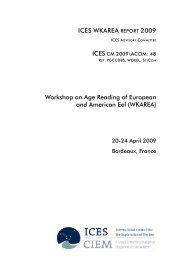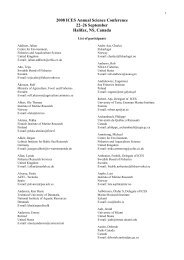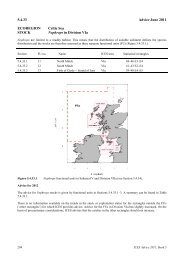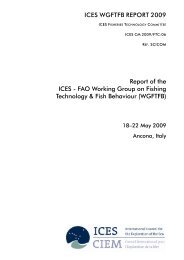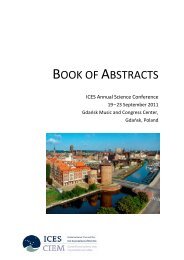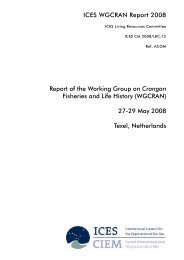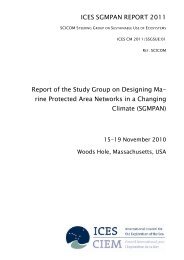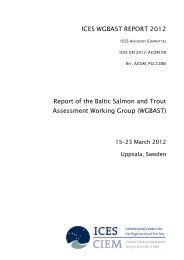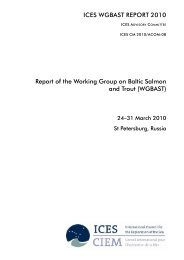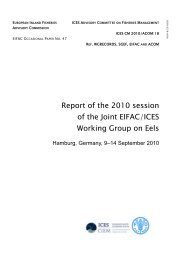Working Group on Seabird Ecology (WGSE). ICES CM 2004/C:05 ...
Working Group on Seabird Ecology (WGSE). ICES CM 2004/C:05 ...
Working Group on Seabird Ecology (WGSE). ICES CM 2004/C:05 ...
- TAGS
- seabird
- ecology
- ices
- www.ices.dk
You also want an ePaper? Increase the reach of your titles
YUMPU automatically turns print PDFs into web optimized ePapers that Google loves.
Gjerdrum, C.G., Vallée, A.M.J., St. Clair, C.C., Bertram, D.F., Ryder, J.L. and Blackburn, G.S. 2003. Tufted puffin<br />
reproducti<strong>on</strong> reveals ocean climate variability. Proceedings of the Nati<strong>on</strong>al Academy of Science of the USA, 100:<br />
9377–9382.<br />
Harding, A.M.A., Piatt, J.F. and Hamer, K.C. 2003. Breeding ecology of horned puffins (Fratercula corniculata) in<br />
Alaska: annual variati<strong>on</strong> and effects of El Niño. Canadian Journal of Zoology, 81: 1004–1013.<br />
<strong>ICES</strong>. 2003. Report of the <str<strong>on</strong>g>Working</str<strong>on</strong>g> <str<strong>on</strong>g>Group</str<strong>on</strong>g> <strong>on</strong> <strong>Seabird</strong> <strong>Ecology</strong>. <strong>ICES</strong> <strong>CM</strong> 2003/C:03.<br />
Inchausti, P., Guinet, C., Koudil, M., Durbec, J.-P., Barbraud, C., Weimerskirch, H., Cherel, Y., and Jouventin, P. 2003.<br />
Inter-annual variability in the breeding performance of seabirds in relati<strong>on</strong> to oceanographic anomalies that affect<br />
the Crozet and the Kerguelen sectors of the Southern Ocean. Journal of Avian Biology, 34: 170–176.<br />
Jenouvrier, S., Barbraud, C., and Weimerskirch, H. 2003. Effects of climate variability <strong>on</strong> the temporal populati<strong>on</strong><br />
dynamics of southern fulmars. Journal of Animal <strong>Ecology</strong>, 72: 576–587.<br />
J<strong>on</strong>es, I.L., Hunter, F.M., and Roberts<strong>on</strong>, G.J. 2002. Annual adult survival of least auklets (Aves, Alcidae) varies with<br />
large scale climatic c<strong>on</strong>diti<strong>on</strong>s in the North Pacific Ocean. Oecologia, 133: 38–44.<br />
Oswald, S., Huntley, B., and Hamer, K.C. <strong>2004</strong>. Exploring the impact of climate <strong>on</strong> the distributi<strong>on</strong> of great skuas<br />
breeding in the UK. Abstract, 8 th Internati<strong>on</strong>al <strong>Seabird</strong> <str<strong>on</strong>g>Group</str<strong>on</strong>g> C<strong>on</strong>ference, Aberdeen, 2–4 April <strong>2004</strong>.<br />
Ramos, J.A., Maul, A.M., Ayrt<strong>on</strong>, V., Bullock, I., Hunter, J., Bowler, J., Castle, G., Mileto, R., and Pacheco, C. 2002.<br />
Influence of local and large-scale weather events and timing of breeding <strong>on</strong> tropical roseate tern reproductive<br />
parameters. Marine <strong>Ecology</strong> Progress Series, 243: 271–279.<br />
Schreiber, E.A. 2002. Climate and weather effects <strong>on</strong> seabirds. In Biology of marine birds. Ed. By Schreiber, E.A. and<br />
Burger, J. CRC Press, Boca Rat<strong>on</strong>, Florida: 179–216.<br />
Thomps<strong>on</strong>, K.R., and Furness, R.W. 1991. The influence of rainfall and nest site quality <strong>on</strong> the populati<strong>on</strong> dynamics of<br />
the Manx shearwater Puffinus puffinus <strong>on</strong> Rhum. Journal of Zoology, L<strong>on</strong>d<strong>on</strong>, 225: 427–437.<br />
Thomps<strong>on</strong>, P.M., and Ollas<strong>on</strong>, J.C. 2001. Lagged effects of ocean climate change <strong>on</strong> fulmar populati<strong>on</strong> dynamics.<br />
Nature 413: 417–420.<br />
5 A COMPARISON OF SEABIRD COMMUNITIES AND PREY CONSUMPTION IN THE EAST<br />
AND WEST NORTH ATLANTIC<br />
Term of reference: complete the work carried out in 2003 to compare seabird communities and prey c<strong>on</strong>sumpti<strong>on</strong><br />
between the east and west North Atlantic.<br />
5.1 Introducti<strong>on</strong><br />
The <strong>WGSE</strong> 2002 meeting completed a summary of the breeding seabird numbers by species, total seabird energy<br />
requirements and approximate food c<strong>on</strong>sumpti<strong>on</strong> equivalents, in all <strong>ICES</strong> areas (approximately described as the ‘east<br />
North Atlantic’). Given the pr<strong>on</strong>ounced differences in seabird community compositi<strong>on</strong> and species abundances, and in<br />
fish stocks and fisheries, between the west and east North Atlantic, <strong>WGSE</strong> 2003 thought that it might be instructive to<br />
compare and c<strong>on</strong>trast the patterns of seabird community compositi<strong>on</strong> and energy requirements between <strong>ICES</strong> and<br />
NAFO areas (approximately ‘east’ and ‘west’ North Atlantic), in relati<strong>on</strong> to broad differences in the histories of fish<br />
stocks and fisheries in these areas. We here complete the comparis<strong>on</strong> of the seabird communities and their c<strong>on</strong>sumpti<strong>on</strong><br />
<strong>on</strong> both sides of the North Atlantic. The relati<strong>on</strong>ships to fish stocks and fisheries need to be followed up.<br />
5.1.1 Populati<strong>on</strong> estimates<br />
The estimates of numbers presented here are primarily of birds nesting <strong>on</strong> the coast and feeding wholly or partially at<br />
sea, but the numbers of gulls may also include a small fracti<strong>on</strong> of n<strong>on</strong>-marine, inland-breeding segments of the<br />
populati<strong>on</strong>s. They are based <strong>on</strong> the input by members of the <strong>WGSE</strong> who were asked to provide the best estimates of the<br />
numbers of seabirds currently breeding in their respective countries. Some of these are now several years old, and<br />
predate recent nati<strong>on</strong>al updates. The background data are presented in earlier <strong>WGSE</strong> reports. Although a number of<br />
known caveats have been c<strong>on</strong>sidered here, discrepancies from an updated analysis of the database would probably be<br />
small.<br />
Data from the huge col<strong>on</strong>ies of, e.g., northern fulmars, guillemots, little auks and Atlantic puffins in Canada, Greenland,<br />
Iceland, Svalbard and the Barents Sea should not be c<strong>on</strong>sidered as definitive. Some are quoted as “guesstimates” and<br />
await more detailed censuses. Furthermore, while data for many species were presented to the nearest hundred, ten or<br />
even individual pairs, others were presented as ranges, some as large as 100,000–1,000,000 pairs. For the sake of<br />
simplicity, all such ranges were tabulated as mid-points between the two extremes.<br />
18<br />
<strong>ICES</strong> <strong>WGSE</strong> Report <strong>2004</strong>



